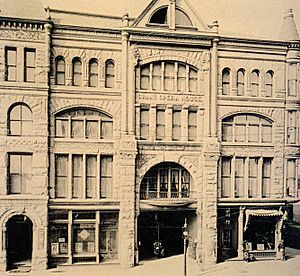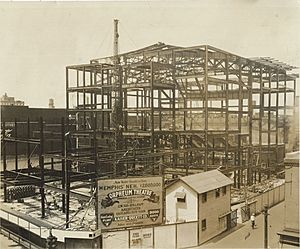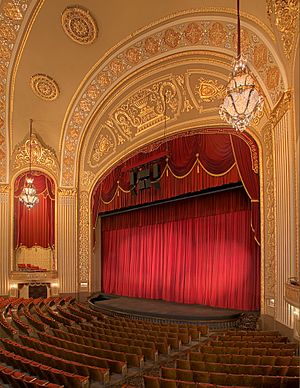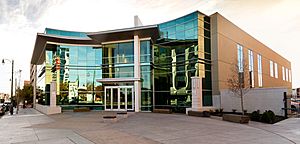Orpheum Theatre (Memphis) facts for kids
|
Orpheum Theatre Group
|
|
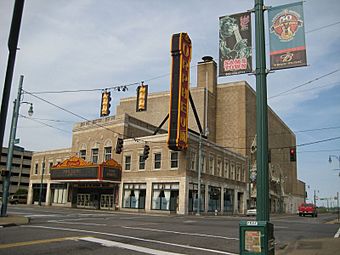 |
|
| Address | 203 South Main Street Memphis, Tennessee United States |
|---|---|
| Public transit | |
| Operator | Orpheum Theatre Group |
| Type | Performing arts center |
| Capacity | 2,308 |
| Construction | |
| Opened | 1928 |
| Reopened | 1984 |
| Website | |
|
Orpheum Theatre
|
|
| Location | 203 South Main Street |
| Architect | C.W. Rapp and George L. Rapp |
| Architectural style | Renaissance |
| NRHP reference No. | 77001289 |
| Added to NRHP | August 15, 1977 |
The Orpheum Theatre is a beautiful old building in downtown Memphis, Tennessee. It has 2,308 seats and is a special place listed on the National Register of Historic Places. You can find it at the corner of South Main and Beale streets.
The Orpheum, along with the Halloran Centre for Performing Arts & Education, are part of the Orpheum Theatre Group. This group is a nonprofit organization that runs both places. They also offer many educational programs for the community.
Contents
What Happens at the Orpheum?
Since 1977, the Orpheum has been the main place in Memphis for big Broadway shows. It also hosts performances by Ballet Memphis and many concerts. You can see comedians, enjoy a summer movie series, or attend family-friendly educational programs.
The theater is also a hub for local events. These include Memphis in May, the International Blues Challenge, and special Elvis Week events. All these activities help make downtown Memphis a lively place.
Keeping the Orpheum Special
The Orpheum Theatre first opened in 1928 and has always been amazing. People love its detailed wood carvings, shiny gold decorations, and beautiful old lights. It even has a huge Wurlitzer organ!
In 1977, a group called the Memphis Development Foundation (MDF) saved the Orpheum. It was one of the first buildings in Memphis to be added to the National Register of Historic Places. Over the past 35 years, more than $15 million has been spent to make it a top-notch theater. These updates have kept its historical beauty while making it a modern performance space.
Orpheum's Early Days
The Grand Opera House
The story of the Orpheum began in 1890. That's when the Grand Opera House opened on the same corner. It was known as one of the fanciest theaters outside New York City.
Back then, vaudeville was very popular. These shows featured singers, musicians, and magicians. In 1907, the Grand Opera House joined the Orpheum Circuit and became known as the Orpheum. Vaudeville shows were a big hit for almost 20 years. But in 1923, after a show, a fire broke out, and the theater burned down.
Building the New Orpheum
A new Orpheum Theatre was built on the same spot. It opened on November 19, 1928. The famous architects Rapp and Rapp designed it. This new theater cost $1.6 million and could seat over 2,300 people. It was twice as big as the old one! It featured sparkling gold and silver, marble, soft carpets, and antique crystal chandeliers. It also had a grand Wurlitzer organ.
As vaudeville became less popular, a movie theater company bought the Orpheum in 1940. They changed its name to the Malco and showed popular movies. By 1976, the company wanted to sell the building. Smaller movie theaters were making more money. There was even talk of tearing the old theater down.
But in 1977, the Memphis Development Foundation bought the theater. They brought back its original name, Orpheum. They started bringing Broadway shows and concerts back to the stage. In 1980, Pat Halloran became the president and CEO, leading the theater for 35 years.
The Mighty Wurlitzer Organ
Even though movies with sound were new in 1927, theaters still had pipe organs. These organs could play music alone or with other instruments. The Orpheum got a special theatre pipe organ from the Wurlitzer Company in 1928.
This organ has over 1,100 pipes! Some are as tall as 16 feet, and others are as small as a pencil. The pipes are hidden in special rooms on either side of the stage. The organ also has percussion instruments like a marimba and xylophone. It can even make sound effects for silent movies, like bird whistles or horse hoofs! The organist plays from a console that can be raised or lowered from the orchestra pit.
In the 1950s, a small fire damaged the organ's console. It was painted white instead of being repaired. Later, gold trim was added. In the 1980s, more pipes were added to give the organ a stronger bass sound.
In June 2017, the Orpheum started a campaign to fix the organ for its 90th anniversary. They aimed to raise $500,000 to restore parts that no longer worked.
Modernizing the Orpheum
1982 Building Restoration
After 54 years, the Orpheum needed a lot of work. On Christmas Day 1982, it closed for a $5 million renovation. The goal was to bring back its 1928 beauty. Crews cleaned and redecorated the building. They also updated the heating and air conditioning. Restrooms and dressing rooms were improved.
Other big changes included new loading docks for shows. The orchestra pit was made larger, and a special lift was added for the stage. The outside of the building was cleaned, and the famous Orpheum sign was repainted. A new lobby area was built with restrooms, a snack bar, and a box office. When the work was done, the Orpheum could seat 2,491 people, including 28 new private suites. The theater reopened in January 1984.
Later Renovations
In 1996, the Orpheum started its biggest renovation ever, costing $8 million. This project expanded the stage and backstage areas. New touring shows needed more space than the theater offered.
By the 1997-98 Broadway season, the stage was 50 feet deep. The orchestra pit was also larger. The renovation added 13 new dressing rooms and a warm-up area for ballet dancers. Two more loading bays were added, doubling the space for equipment. The theater's walls were repainted and decorated with gold leaf. New technical equipment was installed, giving the theater a complete makeover.
Thanks to these improvements, the Orpheum has hosted many huge Broadway shows. These include Disney's Lion King, Wicked, CATS, and Les Miserables. It has also welcomed famous entertainers like Bob Dylan, Jerry Seinfeld, Mary J. Blige, and Harry Connick Jr..
Another renovation happened in 2014, at the same time the Halloran Centre was being built. This work included a new sound system and updated seats. Restrooms were expanded, and decorations were repainted. Some seats were removed to give people more legroom, changing the seating capacity to 2,308. Emergency systems and office spaces were also improved.
Halloran Centre for Performing Arts & Education
In 2013, the Orpheum started a project to build a new facility. They wanted a place for their growing educational programs. In March 2014, construction began. After Pat Halloran, the long-time president, announced his retirement, the board decided to name the new building after him.
The Halloran Centre for Performing Arts & Education opened on September 23, 2015. It is right next to the Orpheum Theatre. This new center is 39,000 square feet and has a 361-seat theater. It also has meeting rooms and rehearsal spaces. It hosts concerts, dance events, and community gatherings like the Indie Memphis Film Festival. The Halloran Centre can also be rented for private events.
The Orpheum Theatre Group
When Pat Halloran retired in 2015, Brett Batterson became the new president and CEO. The Memphis Development Foundation then decided to change its name. In May 2016, the organization became the Orpheum Theatre Group. This new name and logo showed their updated vision.
Growing Programs
As the Orpheum improved its shows, its arts education programs also grew. By 2012, almost 50,000 students, teachers, and families were taking part in these programs.
In March 2020, due to the COVID-19 pandemic, the Orpheum canceled shows for March and April. This was done to keep everyone safe, including the performers who travel.
Ghost Stories at the Orpheum
For over 50 years, people have reported strange things happening at the Orpheum. Many believe the theater is haunted! One of the most famous ghosts is Mary, a 12-year-old girl. Stories differ about how Mary's spirit came to be there. Some say she was in a car accident in 1921. Others believe she was hit by a trolley in 1928 and died inside the theater.
Researchers from the University of Memphis looked into these stories. They used séances and a Ouija board. They also believe a ghost named Mary lives there. Their research suggests Mary died in a falling accident in downtown Memphis in 1921. It had nothing to do with the theater. They believe Mary "wandered into the Orpheum after her death, and she liked it. So she stayed."
People who have seen Mary describe her as shy, with braided brown hair and a white dress. Many performers have seen a little girl in a school uniform sitting in a side box. Her quiet look has surprised some who have seen her. But Mary has never caused trouble during a show.
Memphis historian Vincent Astor and others believe there are up to six other spirits at the Orpheum. One is a male spirit named David. He is supposedly waiting to take Mary to the other side. But since she won't leave, he stays with her. Another spirit, called Eleanor, is in the balcony foyer. Astor described a cold feeling there, but he doesn't think Eleanor is a mean spirit.
There are many tales of flickering lights, tools being moved, and doors swinging open and shut loudly. These events even spooked actor Yul Brynner when he was rehearsing for The King & I in 1982.


